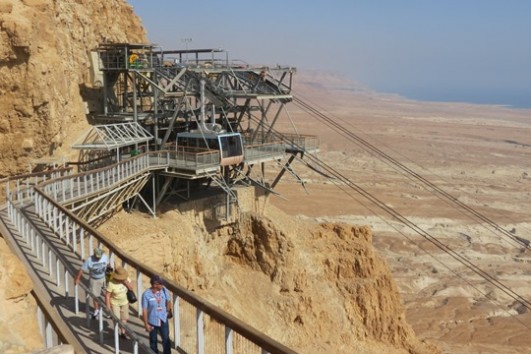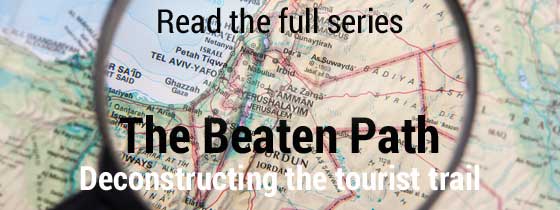Contrary to the strict Israeli narrative, Masada is really what you make of it: it can be the site of a majestic palace, the place where Jewish rebels committed mass suicide, a backdrop for an opera or a tourist attraction complete with the golden arches of a local McDonald’s. Part ten of Yuval Ben-Ami’s journey through the Holy Land’s most popular tourist sites.
A story for you all.
Several years ago, the Tel Aviv-based Israeli Opera decided to launch an opera festival at Masada. Its intention was to use the mountain (and the palace that sits atop it) as a dramatic backdrop. That way it could follow in the footsteps of opera festivals across the world that make use of historical and natural monuments. Clearly the climate on the shores of the Dead Sea is harsh, and the desert surrounding Masada is wild. But the Israeli Opera became committed to the cause, and determined to become the “first opera house in the world to ever pave a road,” in the words of Director Hannah Munitz, it set off into the wild.
The Society for the Preservation of Nature in Israel, however, imposed a restriction. The stage must be set approximately a mile away from Masada itself in order to prevent damage to the rare geological formations at the base of the mountain. The majestic backdrop appears a tad less majestic from the new location. As if they felt the need to compensate, the set-up of the festival grounds was actually quite majestic. With the support of Israel’s Discount Bank, the event’s prime sponsor, the opera company set up a huge reception area. Upon arrival spectators found themselves at a Discount Bank-fest, which resembled an Israeli outdoor wedding, replete with fine refreshments, soft music and promotional banners.
The first opera staged at Masada was, naturally, Aida. The second was Nabbuco. These are the only two operas in the canonical repertoire set in a desert. But Sevilla is a warm place too, so the third year saw the opera put together a production of Carmen. The following year organizers skipped the deserts and heat and just went for La Traviata. I was writing as a theater critic at the time, and went to review each one of those productions. By the time I got to Nabucco I was already over it, especially after riding the Discount-chartered bus for three hours while the bank’s commercials played incessantly on the video screens. I realized that at least artistically, nothing interesting was likely to happen that night. From a cultural perspective, however, the entire phenomenon – the meeting point of money, opera and a potent national-historical symbol at the lowest place on Earth – was quite interesting.
And so I decided not to write about the performance but rather about the entire production. Rather than sit down on the bleachers and take in Masada as a stage prop, I would climb Masada at night and write about what I could see from that vantage point. And that I did. At one point a projector illuminating the entire mountain lit up directly below me, immediately casting my long shadow on the slope. I jumped and hid behind a rock. I don’t think anyone noticed. When it was all over I headed back to Tel Aviv, arriving just before dawn. I went to bed and was woken by a phone call from my angry editor.
“This is not what we asked for,” he said.
“This is what I saw.”
“Just so you know, we are looking for someone to replace you.”
I urged him to take a look at how well the article was doing online. The time was about 9:00 a.m. The piece was up for less than two hours and over 13,000 readers had already visited it. By Hebrew media standards this is insane, especially considering the subject matter. Nevertheless I was laid off soon thereafter under some other pretext.
The non-suicide
There is a specific way to “read” Masada that is seldom challenged by guides or books. But from an archaeological perspective, Masada is at the heart of a lively debate. There is no doubt that Herod had a palace here, and that the palace was used as a bastion by rebels during the Great Jewish Revolt. There is no question that the Romans besieged the mountain or that they broke in by constructing a ramp and driving a battering ram into the walls. The question is whether everyone inside was dead or not. The mass suicide at Masada is told to us by a single source: the historian Josephus Flavius, who may have had a vested interest in telling the story the way he did.
Josephus was a rebel, and he himself initiated a mass suicide at another bastion: Yodfat in the Galilee. Josephus manipulated the lots at Yodfat in order to remain the last man standing. He then failed to kill himself. Instead he turned himself in to the Romans before flattering their centurion so effectively that he was freed. This is not an appealing story, and certainly does not present the man in a very nice light. One way to divert attention from it would be to relocate it to Masada and tell it as a tale of heroism. No major human remains were found at the top of Masada, and many other details contradict Josephus’s professedly second-hand account.
Having said that, the Yodfat incident could well serve to support the Masada suicide story. It teaches us that such things actually happened in those crazy days. Either way, Masada calls for us to think openly. We no longer live in times of almighty builder kings such as Herod the Great, who commissioned a breathtaking stone palace in the middle of the desert. We no longer live in times when nearly a thousand people kill themselves so as not to be taken captive by an enemy army. I cannot even fathom such a thing happening in the current, brutal reality in Syria and Iraq.
Masada demands that we open our minds and use our imagination. Ironically, there is hardly any site in the entire country where visitors are more strictly urged to adhere to a specific narrative and to stick to a well-charted tour. The introductory film at the visitor center, narrated by a man who strongly reminds me of George Constanza, leaves no room for alternative scholarship on the site.
I always leave the screening thinking about this George Constanza fellow – about different models of the Jewish man, from Elazar Ben Yair, commander of the Masada Zealots, to Woody Allen, to the stereotype of the Israeli soldier. It may seem like a silly thought, but it is also a gateway to our issues of identity; I truly believe it is something worthwhile to ponder. Here then, is my tip for Masada: observe it differently. When told to look around you, look down. When told to look up, look around you. When told a story, think about who tells it. You will discover new things.
Looking up, looking down
Let’s give it a shot. You’re at the foot of Masada. Don’t look up – look around you. What do you see? A McDonald’s.
Yes indeed. There is McDonald’s at Masada. Should we blot it out in order not to spoil our experience of the landmark? Let’s instead contemplate it. Why are the yellow arches here? They are here because an ancient king felt a need to build a refuge in which to protect himself in the case of a coup. There’s one arch for every thousand years that has passed since. The past creates the present, and the present is always a reflection of the past. Who was Herod? He was not a Roman, nor was he a puppet king of the Romans. Rather, he was a franchise king, much like the local manager running this joint. Herod operated the local branch of an empire that spread its culinary tastes and cultural tendencies throughout what was then known of the world.
Read more: Yuval Ben-Ami time travels in Bethlehem
Let’s go on to the top. Looking around makes sense, since the palace is beautifully preserved. But look down and you’ll see something even more breathtaking. Remains of walls trail the bottom of the mountain, dotted with peculiar, stone squares. These are the walls of Roman camps. The desert that preserved the palace also managed to preserve the very drama of the siege. This is the land of the frozen moment, where not only eras or life stories are preserved in stone – so are events, punches, feelings. Masada is a monument made up of moments: the quarrying of the stones for construction, the single brief visit Herod may have paid here during his struggle with the Parthians (though there is no solid proof that he ever actually visited), the rebels, the siege, the Roman assault.
Look further at the Dead Sea. At the time of the revolt it was still a single, large body of water, and remained so until the late 20th century, when phosphate mining and diversion of the Jordan River’s waters caused it to shrink and split into two basins. This is the current moment, and it counts at least as much as the past. Look further at the desert: the fascinating geological history of this region submerged under water for eons, makes for a story at least as dramatic as the human one. This is the distant past. This is also the present. Processes are still taking place here. Masada is still being shaped.
Masada is about imagining. Don’t limit yourselves to one version of the tale or notions of scale and proportion, time and space that are not your own. Make your own Masada. Herod saw a dramatic geological formation and turned it into a palace, the rebels saw a palace and turned it into a fortress. Later came monks who saw a ruined fortress and turned it into a monastery. Finally, Israelis came and turned it into a symbol: a tourist attraction, an excavation site, a McDonald’s, an opera venue. Now we are here, on the world’s most fluid rock, and what we think of it is up to us.
Read parts one, two, three, four, five, six, seven, eight and nine of ‘The Beaten Path.’





